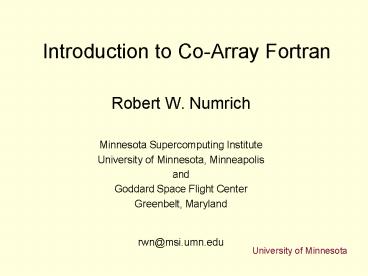Introduction to CoArray Fortran - PowerPoint PPT Presentation
1 / 34
Title:
Introduction to CoArray Fortran
Description:
Co-Array Fortran is one of three simple language extensions to support explicit ... Runs on the HP-Alpha systems at PSC and GSFC. Runs on SGI platforms ... – PowerPoint PPT presentation
Number of Views:48
Avg rating:3.0/5.0
Title: Introduction to CoArray Fortran
1
Introduction to Co-Array Fortran
- Robert W. Numrich
- Minnesota Supercomputing Institute
- University of Minnesota, Minneapolis
- and
- Goddard Space Flight Center
- Greenbelt, Maryland
- rwn_at_msi.umn.edu
2
What is Co-Array Fortran?
- Co-Array Fortran is one of three simple language
extensions to support explicit parallel
programming. - Co-Array Fortran (CAF) Minnesota
- Unified Parallel C (UPC) GWU-Berkeley-NSA-Michigan
Tech - Titanium ( extension to Java) Berkeley
- www.pmodels.org
3
Programming Model
- Single-Program-Multiple-Data (SPMD)
- Fixed number of processes/threads/images
- Explicit data decomposition
- All data is local
- All computation is local
- One-sided communication thru co-dimensions
- Explicit synchronization
- Is this model still adequate?
4
Co-Array Fortran Execution Model
- The number of images is fixed and each image has
its own index, retrievable at run-time - 1 ? num_images()
- 1 ? this_image()
num_images() - Each image executes the same program
independently of the others. - The programmer inserts explicit synchronization
and branching as needed. - An object has the same name in each image.
- Each image works on its own local data.
- An image moves remote data to local data through,
and only through, explicit co-array syntax.
5
Declaration of a Co-Array
real x(n)?
6
Co-Array Fortran Memory Model
p
q
x(1) x(n)
x(1)
x(1) x(n)
x(1)q
x(1) x(n)
x(1) x(n)
x(n)p
x(n)
7
What Do Co-Dimensions Mean?
- real x(n)p,q,?
- Replicate an array of length n, one on each
image. - Build a map so each image knows how to find the
array on any other image. - Organize images in a logical (not physical)
three-dimensional grid. - The last co-dimension acts like an assumed size
array ? ? num_images()/(pxq)
8
Examples of Co-Array Declarations
real a(n)? complex z0? integer
index(n)? real b(n)p, ? real
c(n,m)0p, -7q, 11? real, allocatable
w() type(field) maxwellp,?
9
Communication Using CAF Syntax
y() x()p x(index()) yindex() x()q
x() x()p
Absent co-dimension defaults to the local object.
10
An Example from the UK Met Unified Model
11
Alias to Local Fields
- real, allocatable u(,,)
- allocate( u(0m1,0n1,levels))
- type(field) zp,?
- zptr gt u
12
Alias to Remote Data
zp,qptr
zptr
zptr
u
u
13
Problem Decomposition and Co-Dimensions
N
E
W
S
14
Cyclic Boundary Conditions East-West Direction
- real,dimension p, z
- myP this_image(z,1) !East-West
- West myP - 1
- if(West lt 1) West nProcEW !Cyclic
- East myP 1
- if(East gt nProcEW) East 1 !Cyclic
15
East-West Halo Swap
- Move last row from west to my first halo
- u(0,1n,1lev) zWest,myQptr(m,1n,1lev
) - Move first row from east to my last halo
- u(m1,1n,1lev)zEast,myQField(1,1n,1lev)
16
Total Time (s)
17
Co-Array Fortran and Object-Oriented
Programming Methodology
18
CafLib A Parallel Class Library for Co-Array
Fortran
- Combine the object-based features of Fortran 95
with co-array syntax to obtain an efficient
parallel numerical class library that scales to
large numbers of processors. - Encapsulate all the hard stuff in modules using
named objects, constructors,destructors, generic
interfaces, dynamic memory management.
19
CAF Parallel Class Libraries
use BlockMatrices use BlockVectors
type(PivotVector) pivotp,
type(BlockMatrix) ap, type(BlockVector)
x call newBlockMatrix(a,n,p) call
newPivotVector(pivot,a) call newBlockVector(x,n)
call luDecomp(a,pivot) call solve(a,x,pivot)
20
LU Decomposition
21
Communication for LU Decomposition
- Row interchange
- temp() a(k,)
- a(k,) a(j,) p,myQ
- a(j,) p,myQ temp()
- Row Broadcast
- L0(in,i) a(i,n,i) p,p i1,n
- Row/Column Broadcast
- L1 (,) a(,) myP,p
- U1(,) a(,) p,myQ
22
CAF I/O for Named Objects
use BlockMatrices use DiskFiles
type(PivotVector) pivotp,
type(BlockMatrix) ap, type(DirectAccessDis
kFile) file call newBlockMatrix(a,n,p)
call newPivotVector(pivot,a) call
newDiskFile(file) call readBlockMatrix(a,file)
call luDecomp(a,pivot) call writeBlockMatrix(a,
file)
23
What about Synchronization?
24
Synchronization Intrinsic Procedures
- sync_all()
- Full barrier wait for all images before
continuing. - sync_all(wait())
- Partial barrier wait only for those images in
the wait() list. - sync_team(list())
- Team barrier only images in list() are
involved. - sync_team(list(),wait())
- Team barrier wait only for those images in the
wait() list. - sync_team(myPal)
- Synchronize with one other image.
25
Events
sync_team(list(),list(meme)) post
event sync_team(list(),list(youyou)) wait
event
26
New Sync Intrinsic Procedures ?
- call teamNotify(teamList())
- call teamWait(teamList())
- readyList() teamReady(teamList())
27
Co-Array Fortran and Component Frameworks
28
Component Frameworks
- Component frameworks provide interfaces between
different applications. - The Common Component Architecture (CCA) is
supported by DoE - The Earth System Modeling Framework (ESMF) is
supported by NASA/NOAA - Can Co-Array Fortran support component frameworks?
29
Team Context
- call setTeam(teamList())
- real x ? real xteamList()
- allocate(x) ? allocate(xteamList()
- call syncAll() ? call syncTeam(teamList())
30
Co-Procedures
- type x
- real a(n)
- contains
- method
- end type
- type(x) y
- b() ypa()
- b() ypmethod()
31
Where Can I Try Co-Array Fortran?
32
The Co-Array Fortran Standard
- Co-Array Fortran is defined by
- R.W. Numrich and J.K. Reid, Co-Array Fortran for
Parallel Programming, ACM Fortran Forum,
17(2)1-31, 1998 - Additional information on the web
- www.co-array.org
- www.pmodels.org
33
CRAY Co-Array Fortran
- CAF has been a supported feature of Cray Fortran
90 since release 3.1 - CRAY T3E
- f90 -Z src.f90
- mpprun -n7 a.out
- CRAY X1
- ftn -Z src.f90
- aprun -n7 a.out
34
Co-Array Fortran on Other Platforms
- Rice University is developing an open source
compiling system for CAF. - Runs on the HP-Alpha systems at PSC and GSFC
- Runs on SGI platforms
- IBM may put CAF on the BlueGene/L machine at
LLNL. - DARPA High Productivity Computing Systems (HPCS)
Project wants CAF. - IBM, CRAY, SUN































